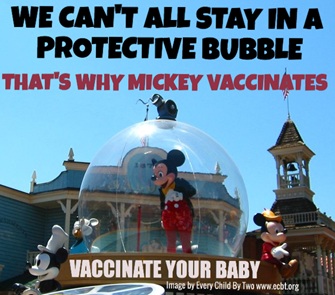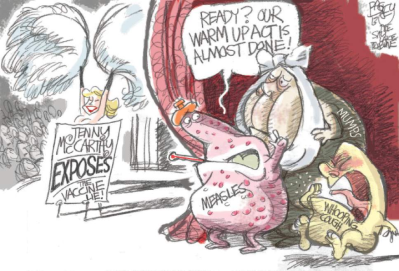This is a continuation to the previous post regarding vaccination myths. After reading Part 1, we hope that parents will make decisions based on the pyramid on the left below:
‘Improved living standards, not vaccination, have reduced infectious diseases’
Some argue that improved living standards, not vaccination, have contributed to the significant decline in infectious diseases over the last century.
While disease mortality reduced substantially due to improvements in living standards and healthcare quality, the benefits of vaccines are further illustrated by the drop in mortality cases from vaccine-preventable diseases such as diphtheria, pertussis, polio and measles. Improvements in living conditions and healthcare alone are not capable of producing such results in a short period of time.
To support this argument, let’s include some statistics regarding the impact of vaccines on the incidence of infectious diseases:
1. Haemophilus influenza B (Hib) vaccine, which was first introduced into the Australian standard vaccination schedule in 1993, led to a significant decline in the number of Hib cases from 560 cases in 1992 to only 39 cases in 2006–2007. Sanitation levels and living conditions have been stagnant during this period of time and thus the decline in Hib cases cannot be attributed to living standards alone.

Incidence of Hib disease from 1990-2008 in U.S. The incidence of Hib disease began to decline dramatically, which coincide with introduction of conjugate Hib vaccines in 1987. Overall, Hib has declined by more than 99% compared with the pre-vaccine era.
2. Similarly, the introduction of conjugate meningococcal C vaccine in Australia during early 2003 has led to a decrease in incidence from 225 notified cases per year to only less than 15 cases per year.
‘My unvaccinated child should be of no concern to your vaccinated one’

Remember the measles outbreak in California’s Disneyland amusement park which spread across different states?
Have you ever wonder why SOME people get it but NOT others?
 It is essential to maintain high vaccination rates within a population as it provides protection for people who are vulnerable to vaccine preventable diseases. This phenomenon is known as ‘herd immunity’. People who rely heavily on herd immunity include very young children, immunocompromised and elderly populations as they are unable to receive vaccination. Therefore, vaccination rates need to be high within a population for herd immunity to be effective.
It is essential to maintain high vaccination rates within a population as it provides protection for people who are vulnerable to vaccine preventable diseases. This phenomenon is known as ‘herd immunity’. People who rely heavily on herd immunity include very young children, immunocompromised and elderly populations as they are unable to receive vaccination. Therefore, vaccination rates need to be high within a population for herd immunity to be effective.
 Following the measles outbreak in California, researchers at Boston Children’s Hospital analysed case numbers reported by the California Department of Public Health to estimate vaccination rates of the affected areas. The vaccination rates for the areas were between 50%-86%, which is significantly lower than the 96%-99% rate required in providing herd immunity! This is an example on how a drop in vaccination rate can lead to re-emergence of diseases!
Following the measles outbreak in California, researchers at Boston Children’s Hospital analysed case numbers reported by the California Department of Public Health to estimate vaccination rates of the affected areas. The vaccination rates for the areas were between 50%-86%, which is significantly lower than the 96%-99% rate required in providing herd immunity! This is an example on how a drop in vaccination rate can lead to re-emergence of diseases!
How would you feel if your child was the one responsible for measles epidemic in Disneyland?
It is crucial to understand that:
“Vaccination is not just a personal issue, it’s a community responsibility”.
‘Vaccines cause or spread the diseases they are supposed to prevent’
There are 7 types of vaccines available in the market: live-attenuated vaccines, inactivated vaccine, subunit vaccines, toxoid vaccines, conjugate vaccine, DNA vaccines and recombinant vector vaccines.
All of the vaccines, except for live-attenuated vaccine, contain inactivated pathogen materials which are incapable of causing the disease. On the other hand, live-attenuated vaccine contains an active and weakened form of the virus that it aims to protect from.
The MMR vaccine is an example of a live-attenuated vaccine. 5% of the population develop a rash after vaccination, which mimics the mild symptoms of measles. However, the vaccine protects individual against full blown complications such as measles encephalitis, which occur 1 in a million vaccinated children compared to 1 in 1000 children who have contracted measles!
In addition, the risk of transmitting vaccine virus is extremely rare. In the United States, out of 56 million doses of varicella vaccines distributed over 10 years, there have been only 6 documented cases of virus transmission from an immuno-competent person who is vaccinated.
‘Since cases of vaccine-preventable disease occur in those who have been vaccinated, vaccines are not effective’
Remember like all other medications, no vaccine is 100% effective. While it’s still possible to get the disease you’ve been vaccinated against, disease severity and duration will most likely be reduced. Here is the explanation as to why not everyone benefits from vaccination.
To make vaccines safer than the disease, attenuated (weakened) or dead bacteria or virus are utilised. Due to variation in individual genetics, not all vaccinated people develop immunity. Most routine childhood vaccines are 85%-95% effective. Hence, for every 100 vaccinated individuals, 5-15 may not develop protective immunity.
But this does not mean that the vaccine is not effective. Upon exposure to measles, it is almost certain that 100 percent of all un-vaccinated children will be infected as compared to only 1% for children who received vaccination. Considering the high virulence associated with measles, there would probably have been many more cases if herd immunity was not present.

Interactive map showing the re-emergence of vaccine preventable diseases. Each circle on the map represents a local outbreak of a particular disease, while the size of the circle indicates the number of people infected in the outbreak.
As illustrated by this interactive map from the Council on Foreign Relations, several diseases that are easily prevented with vaccines have made a comeback in the past few years. The surge of these diseases coincides with changes in views about vaccine safety.
Even though the 1998 study (mentioned in Part 1) was found to be fraudulent, fears about vaccine safety have lingered around Europe and the United States till today.
As a result, viruses and bacteria have taken full advantage of the immunisation gaps!
- Measles has re-emerged as an endemic problem in Europe and U.S (2014)
- Rising prevalence of whooping cough is becoming an issue in the U.S.
- In 2011, a massive measles outbreak of 15,000 cases was reported in France
- In 2012, there were more than 2,000 measles cases in the U.K
What about Africa? Why are there multiple outbreaks of vaccine preventable diseases? For many of them, the problem is due to poor accessibility to vaccines and not fears.
After reviewing both pros and cons of the issues revolving around vaccinations, which side are you on?
If you are still unsure about why vaccination is so important, maybe this video can enlighten you
Text References:
Majumder MS, Cohn EL, Mekaru SR, Huston JE, Brownstein JS. Substandard Vaccination Compliance and the 2015 Measles Outbreak. JAMA Pediatr [Internet]. 2015 [cited 2015 Mar 30]; 5(4):323-70. Available from: Medline
Council on Foreign Relations. Vaccine-Preventable Outbreaks: Maps [Internet]. New York City (NY): Council on Foreign Relations; 2015 [cited 2015 Mar 30]. Available from: http://www.cfr.org/interactives/GH_Vaccine_Map/index.html#map
Department of Health and Ageing (AU). Myths and Realities- Responding to arguments against vaccination: A guide for providers [Internet]. Melbourne(VIC): Australian Government; Department of Health and Ageing; 2013 [cited 2015 Mar 30]. Available from: http://www.immunise.health.gov.au/internet/immunise/publishing.nsf/Content/1FC63A2886238E6CCA2575BD001C80DC/$File/full-publication-myths-and-realities-5th-ed-2013.pdf
Image references:
Laika’s medLibLog. EBM pyramid [Internet]. Worpress.Org; 2008 [cited 2015 Mar 30]. [Figure], Pyramid. Available from: https://laikaspoetnik.wordpress.com/2008/09/26/time-to-weed-the-ebm-pyramids/
Centers for Disease Control and Prevention (US). Haemophilus influenza type B [Internet]. Atlanta(GA): Centers for Disease Control and Prevention; 2012 [cited 2015 Mar 30]. [Figure], Incidence* of Invasive Hib Disease, 1990-2009. Available from: http://www.cdc.gov/vaccines/pubs/pinkbook/hib.html
Centers for Disease Control and Prevention (US). Measles Cases and Outbreaks [Internet]. Atlanta(GA): Centers for Disease Control and Prevention; 2014 [cited 2015 Mar 30]. [Figure], Measles Cases and Outbreaks. Available from: http://www.cdc.gov/measles/cases-outbreaks.html
Parasite Ecology. Vaccination Coverage and Herd Immunity [Internet]. Worpress.Org; 2014 [cited 2015 Mar 30]. [Figure], Life without vaccination: a sad story. Available from: https://parasiteecology.wordpress.com/2014/03/26/vaccination-coverage-and-herd-immunity/
Vara C. Disneyland Measles Outbreak: Should You Be Concerned [Internet]. Shot of Prevention: News and Views on Vaccines; 2015 Jan [cited 2015 Mar 30]. [Figure], Vaccinate your baby. Available from: http://shotofprevention.com/?s=why+worry+about+the+unvaccinated
The Cagle Post. Pat Bagley: Anti Vaccine Reunion Tour [Internet]. Santa Barbara (CA): Cagle Cartoon Inc; 2013 [cited 2015 Mar 30]. [Figure]. Anti Vaccine Reunion Tour. Available from: http://www.cagle.com/2013/11/anti-vaccine-reunion-tour/


